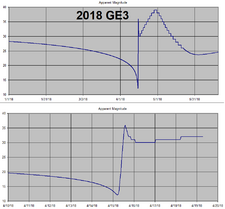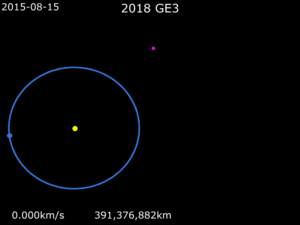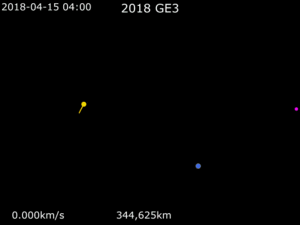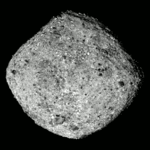Astronomy:2018 GE3
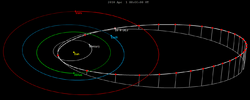 The orbit of 2018 GE3 with 30-day markers | |
| Discovery [1] | |
|---|---|
| Discovered by | Catalina Sky Srvy. |
| Discovery site | Catalina Stn. |
| Discovery date | 14 April 2018 (first observed only) |
| Designations | |
| 2018 GE3 | |
| Minor planet category | NEO · Apollo [1][2] |
| Orbital characteristics [2] | |
| Epoch 23 March 2018 (JD 2458200.5) | |
| Uncertainty parameter 7 | |
| Observation arc | 4 days |
| |{{{apsis}}}|helion}} | 3.3782 AU |
| |{{{apsis}}}|helion}} | 0.3179 AU |
| 1.8481 AU | |
| Eccentricity | 0.8280 |
| Orbital period | 2.51 yr (918 d) |
| Mean anomaly | 333.94° |
| Mean motion | 0° 23m 32.28s / day |
| Inclination | 8.7368° |
| Longitude of ascending node | 25.412° |
| 300.17° | |
| Earth MOID | 0.0010 AU (0.3896 LD) |
| Mercury MOID | 0.0101 AU |
| Venus MOID | 0.0556 AU |
| Mars MOID | 0.0527 AU |
| Physical characteristics | |
| Mean diameter | 48–110 m[3] 48 m (est. at 0.24)[4] 100 m (est. at 0.05)[4] |
| Absolute magnitude (H) | 23.813[2] |
2018 GE3 is a sub-kilometer asteroid on a highly eccentric orbit, classified as a near-Earth object of the Apollo group, approximately 48–110 meters (160–360 feet) in diameter. It was first observed on 14 April 2018, by astronomers with the Catalina Sky Survey one day prior to its sub-lunar close encounter with Earth at 0.5 lunar distance.[2] It is one of the largest known asteroids (possibly the largest) in observational history to ever pass that close to Earth (also see list).
Orbit and classification
2018 GE3 is a member of the near-Earth population of asteroids known as Apollos.[1][2] Apollo asteroids cross the orbit of Earth and are the largest group of near-Earth objects with nearly 10 thousand known members. Based on an observation arc of 4 days, it orbits the Sun at a distance of 0.3–3.4 AU once every 2 years and 6 months (918 days; semi-major axis of 1.85 AU). Its orbit has an unusually high eccentricity of 0.83 and an inclination of 9° with respect to the ecliptic.[2] It is also a Mercury-, Venus- and Mars-crosser, reaching its furthest point from the Sun in the outer asteroid belt. The body's observation arc begins at Steward Observatory's Catalina Station with its first observation in April 2018.[1]
Close encounters
In observational history, and other than possibly 2002 MN and 2017 VW13, this asteroid is the largest known object to ever pass that close to Earth, as well as the Moon (also see History of closest approaches of large near-Earth objects).[lower-alpha 1] 99942 Apophis will break both of these records when it approaches only 0.098 LD (0.000252 astronomical unit|AU) from Earth on 13 April 2029.
2018 flyby
2018 GE3 was first observed on 14 April 2018, at 09:23 UT by astronomers at Steward Observatory's Catalina Station, Arizona, the day prior to its close encounter with Earth.
It had been more than 120 degrees from the Sun since March 2018, but was simply too far and too faint to be detected by automated surveys. Despite coming from directly away from the Sun, it was not discovered until 14 April 2018, only one day prior to its closest approach. If the most advanced survey telescopes had been looking at its location, it could have been discovered as early as 30 March. On 15 April 2018, at 06:41 UT, this object passed Earth at a nominal distance of 0.50 LD (0.001289 AU) which corresponds to a distance of 193,000 kilometres (120,000 miles), at a speed of 29.5 km/s (66,000 mph).[2][3] The object also approached the Moon at an even closer distance of 0.34 LD (0.00087 AU) a few hours later, at 09:59 UT.[2]
It was the 32nd known asteroid to flyby Earth within 1 lunar distance (LD) since the start of 2018 and 16th closest, although it was the largest known asteroid to pass within half a lunar distance. After closest approach its apparent magnitude dropped from 12 to 35 in less than 12 hours, heading towards the Sun. Coming from the opposite direction, it would have been impossible to observe before its approach. A preliminary analysis of the orbit of 2018 GE3 shows that this is the closest this particular asteroid has come to Earth since at least 1930.[3]
Historical close encounters
Asteroid 2002 MN passed closer to Earth than 2018 GE3 in 2002, and had a brighter absolute magnitude (H) of 23.6, and could be either larger or smaller than 2018 GE3, depending on their albedos and thus exact sizes. 2017 VW13 (H=20.7) may have also passed closer in 2001, although the distance of its approach is very uncertain and it was not discovered until 2017.[5]
Physical characteristics
Diameter and albedo
The diameter can only be estimated based on the brightness and distance. The albedo is currently unknown. Based on a generic magnitude-to-diameter conversion, 2018 GE3 measures between 48–100 meters (157–328 feet) in diameter, for an absolute magnitude of 23.8,[2] and an assumed albedo between 0.05 and 0.24, which represent typical values for carbonaceous and stony asteroids, respectively.[4]
This asteroid is about three to six times the diameter of the meteor that exploded in the skies above Chelyabinsk, Russia in February 2013, which damaged over 7,200 buildings and injured 1,500 people, mostly from flying glass. If an asteroid of this size were to enter Earth's atmosphere, a good portion of it would likely disintegrate due to friction with the air. The remnants could survive entry however and impact the surface, thus causing regional damage dependent on various factors such as composition, speed, entry angle, and location of impact.[3]
Rotation period
As of 2018, no rotational lightcurve of 2018 GE3 has been obtained from photometric observations. The body's rotation period, pole and shape remain unknown.[2]
Numbering and naming
This minor planet has neither been numbered nor named.[1]
See also
- List of asteroid close approaches to Earth
- List of asteroid close approaches to Earth in 2018
- 2018 AH, a slightly larger asteroid that also passed unusually close to Earth in 2018.
Notes
- ↑ 2002 MN has a brighter absolute magnitude than this asteroid (23.6 vs. 23.8) and may therefore be larger. Note that the term "observational history" excludes objects such as 2017 VW13 not yet discovered at the time of close approach. Furthermore, 2017 VW13's orbit is uncertain enough that it may not have passed closer than 2018 GE3 at all.
References
- ↑ 1.0 1.1 1.2 1.3 1.4 "2018 GE3". Minor Planet Center. https://www.minorplanetcenter.net/db_search/show_object?object_id=2018+GE3. Retrieved 15 April 2018.
- ↑ 2.0 2.1 2.2 2.3 2.4 2.5 2.6 2.7 2.8 2.9 "JPL Small-Body Database Browser: (2018 GE3)". Jet Propulsion Laboratory. https://ssd.jpl.nasa.gov/sbdb.cgi?sstr=3802568;cad=1. Retrieved 28 April 2018.
- ↑ 3.0 3.1 3.2 3.3 "Asteroid buzzed Earth this weekend". EarthSky. http://earthsky.org/space/asteroid-2018-ge3-passed-earth-apr-15-2018. Retrieved 16 April 2018.
- ↑ 4.0 4.1 4.2 "Asteroid Size Estimator". CNEOS NASA/JPL. https://cneos.jpl.nasa.gov/tools/ast_size_est.html. Retrieved 28 April 2018.
- ↑ "JPL Small-Body Database Browser: (2017 VW13)". Jet Propulsion Laboratory. https://ssd.jpl.nasa.gov/sbdb.cgi?sstr=2017VW13;cad=1.
External links
- Asteroid 2018 GE3 flew past Earth at 0.5 LD, The Watchers, 16 April 2018
- "Tunguska"-Size Asteroid Makes Surprise Flyby of Earth, www.space.com, 16 April 2018
- Asteroid as big as a warehouse is freakiest near miss in years, www.cnet.com, 16 April 2018
- List Of Apollo Minor Planets (by designation), Minor Planet Center
- Asteroid Lightcurve Database (LCDB), query form (info )
- 2018 GE3 at NeoDyS-2, Near Earth Objects—Dynamic Site
- Ephemeris · Obs prediction · Orbital info · MOID · Proper elements · Obs info · Close · Physical info · NEOCC
- 2018 GE3 at ESA–space situational awareness
- 2018 GE3 at the JPL Small-Body Database
 |

